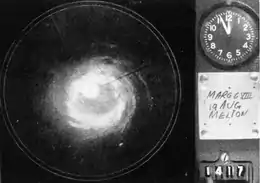Typhoon Marge (1951)
Typhoon Marge was a typhoon that formed in August 1951.
| Category 3 typhoon (SSHWS) | |
 Eye of Typhoon Marge | |
| Formed | August 10, 1951 |
|---|---|
| Dissipated | August 24, 1951 |
| Highest winds | 1-minute sustained: 185 km/h (115 mph) |
| Lowest pressure | ~886 hPa (mbar) |
| Fatalities | Korea, Japan, China |
| Part of the 1951 Pacific typhoon season | |
Meteorological history

Typhoon Marge originated as a tropical storm southeast of Guam on August 10. Tracking towards the northwest, the strengthening system passed just south of the island the following day as a typhoon. On August 13, the storm began taking a more northwesterly path as it continued to intensify, reaching its peak intensity two days with maximum winds estimated at 185 km/h (115 mph) and a remarkably low pressure of 886 mbar (hPa; 26.16 inHg). Fluctuating in strength over the following days, Marge passed over the Amami Islands on August 18 before a more steadily weakening trend took hold as the typhoon moved into the East China Sea. The storm passed just offshore Shanghai before curving sharply towards the northeast into the Yellow Sea on August 21. Marge weakened to a tropical storm the next day after spending 11 continuous days as a typhoon. The cyclone made landfall near Boryeong, South Korea on August 23 and accelerated northeastwards across the Korean peninsula, transitioning into an extratropical cyclone over far-northeastern Manchuriabefore dissipating after August 24.[1]
Records
Marge was the largest tropical cyclone ever observed to date, with a wind circulation extending 1160 km (720 mi) in diameter; this record stood until it was eclipsed by Typhoon Tip in 1979.[2] Meteorologist Robert Simpson flew on board a reconnaissance mission that flew into Marge near its peak strength and documented the eye's visual and sampled characteristics. The flight was an atypical departure from normal reconnaissance missions due to secondary—albeit procedurally constrained—storm-research objectives.[3] Publishing his findings in the Bulletin of the American Meteorological Society in 1952, his work would be instrumental in the understanding of tropical cyclone structure.[4]
Impact
United Nations naval vessels and United States Navy armaments responding to the Korean War were evacuated from the western coast of the Korean peninsula in advance of the approaching typhoon.[5][6] Gusts as high as 180 km/h (112 mph) were reported in Okinawa in what was considered the island's most impactful typhoon since U.S. military occupation in 1945.[7] Although damage was minimal to U.S. military installations,[8] crop damage was extensive in other parts of Okinawa and several roads and highways were washed out by the heavy rains and surf. Impacts were more extensive further north of Kyushu, where rainfall totals as high as 400 mm (16 in) produced widespread flooding that flooded rice paddies and over a thousand homes, prompting the evacuation of 11,943 people. Offshore, twelve fishing boats capsized in the rough surf, and storm surge killed four in the Kyushu village of Yoshikawa.[9] Across southern Japan, there were 12 deaths and 53 injuries caused by Marge.[10] In South Korea, the Busan area was particularly hard hit, with coastal flooding displacing 550 people from their destroyed wooden homes. A half-mile segment of railroad between Yeosu and Daejeon was also washed out.[11]
References
- "1951 07W:MARGE (1951223N11148)". International Best Track Archive for Climate Stewardship. University of North Carolina-Asheville. Archived from the original on December 25, 2018. Retrieved December 24, 2018.
- National Summary (Report). Climatological Data. 30. Asheville, North Carolina: National Oceanic and Atmospheric Administration. January 1979. p. 96 – via Google Books.
- Simpson, Robert H. (September 1952). "Exploring Eye of Typhoon "Marge," 1951". Bulletin of the American Meteorological Society. Washington, D.C.: American Meteorological Society. 33 (7): 286–298. doi:10.1175/1520-0477-33.7.286.

- "65th Anniversary of Typhoon Marge flight". Hurricane Research Division. Miami, Florida: National Oceanic and Atmospheric Administration. August 15, 2016. Retrieved December 24, 2018.
- "Approaching Typhoon Forces U.N. Ships Off Korea to Move". St. Louis Post-Dispatch. 103 (330). St. Louis, Missouri. Associated Press. August 17, 1951. p. 6A. Retrieved December 23, 2018 – via Newspapers.com.

- "Pacific Typhoon". The Leader-Post. 47 (194). Regina, Saskatchewan. Reuters. August 18, 1951. p. 5. Retrieved December 23, 2018 – via Newspapers.com.

- "Okinawa Rides Out Typhoon". Muncie Evening Press. 59 (167). Muncie, Indiana. International News Service. August 21, 1951. p. 7. Retrieved December 23, 2018 – via Newspapers.com.

- "Storm Sweeps China Sea". Windsor Daily Star. 66 (144). Windsor, Manitoba. United Press. August 18, 1951. p. 1. Retrieved December 23, 2018 – via Newspapers.com.

- "Typhoon Skirts Japan; Six Dead". St. Petersburg Times. 68 (27). St. Petersburg, Florida. Associated Press. August 20, 1951. p. 17. Retrieved December 23, 2018 – via Newspapers.com.

- "Heavy Loss In Typhoon". Mt. Pleasant News. 76 (195). Mt. Pleasant, Iowa. International News Service. August 19, 1951. p. 2. Retrieved December 23, 2018 – via Newspapers.com.

- "Typhoon Hits Korea, Destroys Pusan Homes". The Gazette. Montreal, Quebec. Reuters. August 24, 1951. p. 1. Retrieved December 23, 2018 – via Newspapers.com.
